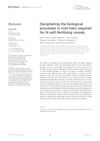12 citations
,
April 2015 in “BMC research notes” Root hairs in cereal crops can grow beyond the usual zone, and using Turface® clay helps study this.
 January 2021 in “Middle East journal of applied sciences”
January 2021 in “Middle East journal of applied sciences” Zinc is essential for plant growth and human health, but many soils lack enough zinc, affecting crops and potentially leading to health problems.
 December 2023 in “Frontiers in plant physiology”
December 2023 in “Frontiers in plant physiology” Root hairs are key for developing cereals that can fertilize themselves with nitrogen.
 March 2025 in “Frontiers in Plant Science”
March 2025 in “Frontiers in Plant Science” The ZmNF-YC1–ZmAPRG pathway in maize improves phosphorus efficiency and grain yield, suggesting it as a target for breeding better crops.
 9 citations
,
January 2003 in “Organic Eprints (International Centre for Research in Organic Food Systems, and Research Institute of Organic Agriculture)”
9 citations
,
January 2003 in “Organic Eprints (International Centre for Research in Organic Food Systems, and Research Institute of Organic Agriculture)” Organic farms need to supplement phosphorus and potassium to maintain soil health and crop yields.



